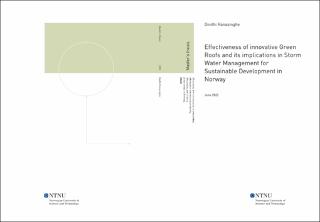| dc.description.abstract | This report reviews the effectiveness of green roof configuration and geometry to be mitigated with climate change tipping points. The rapid urbanization in cities indicates an increased exposure with impermeable roof surfaces to 35% - 45% of land area, which increases the risk of exceeding the design parameters of the existing combined stormwater management system in Norway. The city transformation with green roofs holds numerous benefits in reversing planetary boundaries and this study has concluded with a positive effectiveness in CO2 reduction, hydrological performance, and direct effect for urban heat island effect. The results were found to be more effective for green roofs as a LID, when applied with mild or moderate precipitations in terms of water retention and detention. The increase of the precipitation has shown decrease of the detention ability while retention value decreases as a fraction of the precipitation. However, green roofs show more relevance as an integrated layer or the first step, in the stormwater management system in Norway to act as a method of promoting evapotranspiration as a mitigation to reduce urban heat island effect with latent heat flux as it increases with the water presence increases and reducing stormwater flow peaks by around 80% for increased future precipitation compared to a conventional roof. The volume reduction by retaining water in green roofs as a fraction of the total precipitation, which ranges from 40% to 20% as the precipitation increase from moderate to severe. Even though it can be expecting to have increased runoff volumes as the angle increases, the angle of the green roof shows no effect for the hydrological performance after exceeding the substrate thickness of 140 mm while impermeable roofs show a considerable rise of the peak runoff from around 25% - 30% as the angle increases. The transformation of cities with green roofs have shown a potential of influencing the increase of CO2 sequestration of dense urban cities with lack of spaces for trees, by around 7% CO2 sequestration increase with angular green roofs over flat green roofs. As the green roofs exerts extra structural loads on a building in retrofitting buildings in a city transformation, attention on reduction of structural loads through sloped green roofs has shown a 2% to 8% of reduction of deflection over deflection of a flat roof. Hence, according to the results obtained from this study, the effectiveness of angular green roofs shows higher ability than a flat green roofs and the importance of the green roof within the city scale beholds the fact that it shows enough relevance to be applied in building as a feature or the first step in storm water management process in Norway and the advantages have indicated as far more higher than minor disadvantages such as the cost and extra structural load on roof. | |
